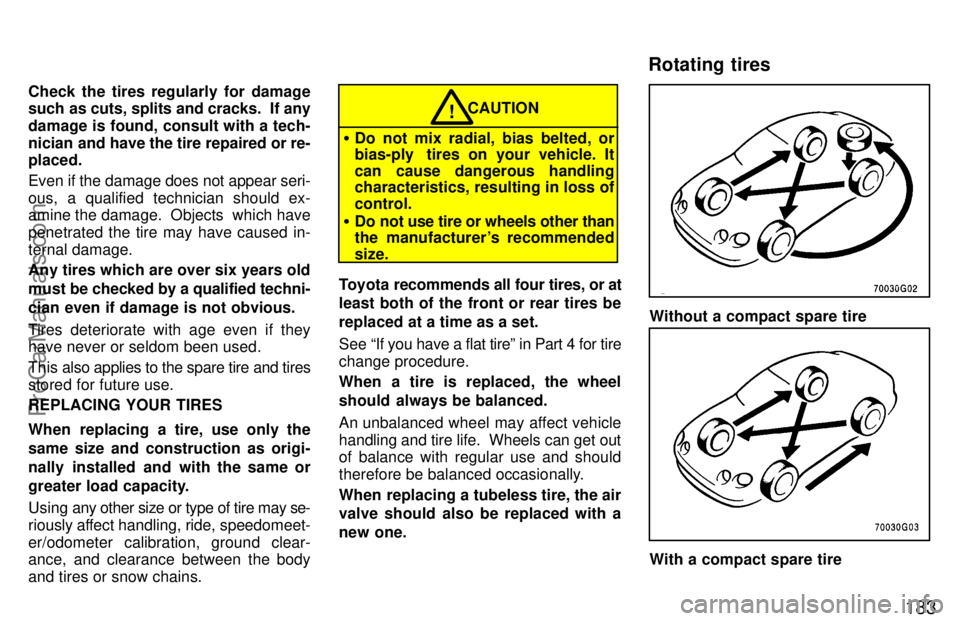Page 9 of 218
4
1. Service reminder indicators or indicator lights
2. Tachometer
3. Odometer and two trip meters 4. Engine coolant temperature gauge
5. Fuel gauge
6. Trip meter
7. Trip meter reset knob
8. Speedometer
Instrument cluster overview
ProCarManuals.com
Page 64 of 218

Part 1Fuel gauge59
OPERATION OF
INSTRUMENTS AND
CONTROLSÐ
Chapter 1-5
Gauges, Meters
and Service reminder
indicators
�Fuel gauge
� Engine coolant temperature
gauge
� Tachometer
� Odometer and trip meter
� Service reminder indicators and
warning buzzers
The gauge works when the ignition
switch is on and indicates the approxi-
mate quantity of fuel remaining in the
tank.
Nearly fullÐNeedle at Fº
Nearly emptyÐNeedle at Eº
It is a good idea to keep the tank over 1/4
full.
This fuel gauge has a non-return type
needle wh ich remains at the last indicated
position when the ignition switch is turned
off.
If the level approaches Eº or the low fuel
level warning light comes on, fill the fuel
tank as soon as possible. If the fuel tank is completely empty, the
malfunction
indicator lamp comes on. Fill
the fuel tank immediately.
The indicator lamp goes off after driving
several times. If the indicator lamp does
not go off, contact your Toyota dealer as
soon as possible.
ProCarManuals.com
Page 66 of 218
61
These meters show the running dis-
tance.
1 OdometerÐIt shows the total dis-
tance the vehicle has been driven.
2 Trip metersÐIt shows the distances
driven since the last time it was set to
zero.
The black digits on white indicate tenths of
kilometers or miles
3 Trip meter reset knobÐIt resets the
trip meter to zero,.
To reset the trip meter, push the knob.
Odometer and trip meterService reminder indicators
and warning buzzers
ProCarManuals.com
Page 189 of 218

183
Check the tires regularly for damage
such as cuts, splits and cracks. If any
damage is found, consult with a tech-
nician and have the tire repaired or re-
placed.
Even if the damage does not appear seri-
ous, a qualified technician should ex-
amine the damage. Objects which have
penetrated the tire may have caused in-
ternal damage.
Any tires which are over six years old
must be checked by a qualified techni-
cian even if damage is not obvious.
Tires deteriorate with age even if they
have never or seldom been used.
This also applies to the spare tire and tires
stored for future use.
REPLACING YOUR TIRES
When replacing a tire, use only the
same size and construction as origi-
nally installed and with the same or
greater load capacity.
Using any other size or type of tire may se-
riously affect handling, ride, speedomeet-
er/odometer calibration, ground clear-
ance, and clearance between the body
and tires or snow chains.
CAUTION
� Do not mix radial, bias belted, or
bias-ply tires on your vehicle. It
can cause dangerous handling
characteristics, resulting in loss of
control.
� Do not use tire or wheels other than
the manufacturer's recommended
size.!
Toyota recommends all four tires, or at
least both of the front or rear tires be
replaced at a time as a set.
See If you have a flat tireº in Part 4 for tire
change procedure.
When a tire is replaced, the wheel
should always be balanced.
An unbalanced wheel may affect vehicle
handling and tire life. Wheels can get out
of balance with regular use and should
therefore be balanced occasionally.
When replacing a tubeless tire, the air
valve should also be replaced with a
new one.
Without a compact spare tire
With a compact spare tire
Rotating tires
ProCarManuals.com
Page 191 of 218

185
If wheel covers are used, they will be
scratched by the chain band, so remove
the covers before putting on the chains.
�Do not exceed 50 km/h (30 mph) or
the chain manufacturer's recom-
mended speed limit, whichever is
lower.
� Drive carefully avoiding bumps,
holes, and sharp turns, which may
cause the vehicle to bounce.
� Avoid sharp turns or locked-wheel
braking, as use of chains may ad-
versely affect vehicle handling.
CAUTION!
Do not attempt to use a tire chain on
the compact spare tire, as it may
result in damage to the vehicle aswell as the tire.
NOTICE
WHEN TO REPLACE YOUR WHEELS
If you have wheel damage such as
bending, cracks or heavy corrosion,
the wheel should be replaced.
If you fail to replace damaged wheels, the
tire may slip off the wheel or they may
cause loss of handling control.
WHEEL SELECTION
When replacing wheels, care should
be taken to ensure that the wheels are
replaced by ones with the same load
capacity, diameter, rim width, and off-
set.
This m ust be observed on compact spare
tires, too.
Correct replacement wheels are available
at your Toyota dealer.
A wheel of a different size or type may ad-
versely affect handling, wheel and bear-
ing life, brake cooling, speedometer/
odometer calibration, stopping ability,
headlight aim, bumper height, vehicle
ground clearance, and tire or snow chain
clearance to the body and chassis. Replacement
with used wheels is not rec-
ommended as they may have been sub-
jected to rough treatment or high mileage
and could fail without warning. Also, bent
wheels which have been straightened
may have structural damage and there-
fore should not be used. Never use an in-
ner tube in a leaking wheel which is de-
signed for a tubeless tire.
Replacing wheels
ProCarManuals.com